I’ll be honest with you, and honest with Toyota, just in case they’re reading this also: I’ve never really understood Toyota’s fascination – perhaps even fixation – on hydrogen cars. I mean, I get the general appeal of it all – hydrogen is the most abundant element in the universe, after all, and if you’re using that hydrogen to power a fuel cell to make electricity (as Toyota does) then the only emissions are pure, clear water. It’s very appealing! On paper, at least.
Reality, though, as usual, is kind of a jerk. Hydrogen may be everywhere in the universe, but here on Earth, where currently Toyota sells 100% of their cars, hydrogen is not that easy to get, and must be produced from other hydrocarbon fuel using thermal-based methods or electrolysis, and so on. It’s not just all floating around out there.
It’s also tricky to store, and a whole new infrastructure for fueling hydrogen needs to be developed, and now we’re getting closer to the whole point of this post: Toyota has been talking about an extensive network of public hydrogen filling stations that will come in the future, but over a decade has passed since the first Mirai hit the market, and as of now there are really only some stations in Southern California (and a handful in Canada if you’re Canadian).
This means that Mirai owners are finding themselves with cars that have pretty severe limitations; you simply can’t take a multi-state road trip in a Mirai, because there’s simply nowhere to refuel. If you own a Mirai, you’re pretty much tethered to whatever California hydrogen station you’re close to. And even then, the refueling situation isn’t great.
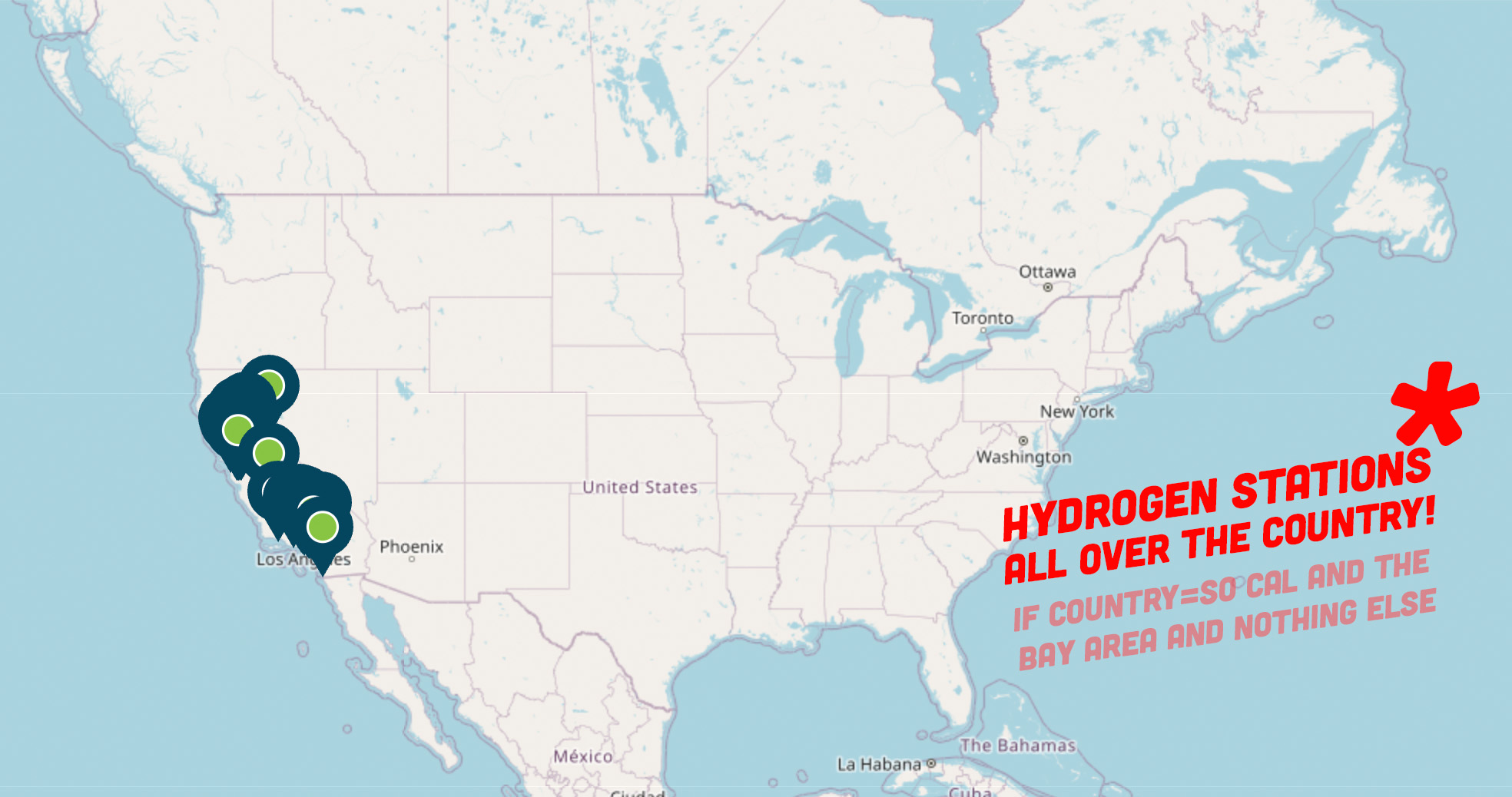
“Isn’t great” is something of an understatement, and the proof of this is that there are hundreds of Mirai owners who are in the process of suing Toyota over problems with hydrogen fueling, including chronic failures of pumps and limited supplies, and also claims that Toyota dealers dramatically oversold the usability of Mirais and did not adequately warn potential buyers of the severe limitations of the car.
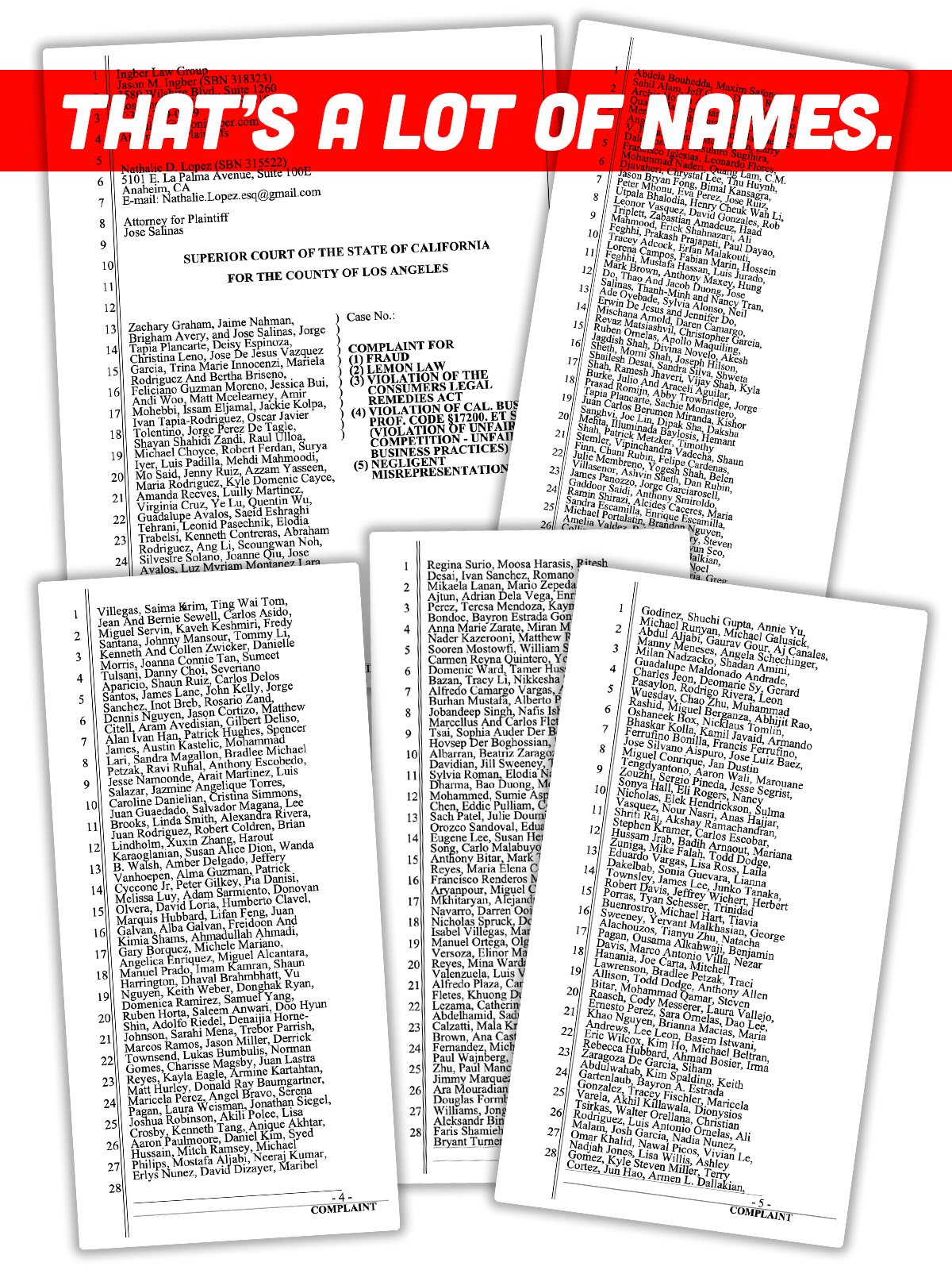
The lawsuit contains a number of personal stories from Mirai owners, and in many of these you can see a combination of a poor refueling infrastructure and what seems to be willful misinformation or, at the very least, exaggeration from Toyota dealers looking to get these Mirai albatrosses off their lots. To be clear, I’m not saying there actually was any deliberate fraud or misinformation – that’s for the courts to decide.
When reached for comment, a Toyota spokesperson told us that the company doesn’t generally comment on pending litigation.
Here’s how the lawsuit describes the situation:
“This action arises from Toyota Motor Sales, U.S.A., Inc.’s fraud in the marketing, sale, and support of its Toyota Mirai hydrogen fuel cell vehicle. Plaintiffs, who represent diverse California consumers including military personnel, seniors, and working families, purchased Toyota’s hydrogen-powered Mirai based on explicit promises of convenient refueling, environmental benefits, and practical usability.
Instead, they received vehicles that are virtually unusable due to a critically deficient hydrogen infrastructure consisting of only 24 fuel nozzles across California, most of which are frequently inoperable.”
There’s also the extremely severe depreciation of Mirais at play here; likely because of the known issues with the cars and their extremely limited sphere of actually being able to be used, Mirais lose a shocking amount of their value quite fast – the lawsuit claims a 90% drop after purchase.
The personal stories of Mirai owners do paint a troubling picture; this one from Zachary Graham, a Second Lieutenant in the Marine Corps, is especially maddening, and I think you’ll see why:
61. Off the bat, Mr. Graham told said Toyota sales associate, [REDACTED], that he was in the military and required flexibility to return the vehicle if he’s stationed out of state.
62. [REDACTED] was explicit that this could be accommodated, and he proposed a finance agreement for a 2023 Toyota Mirai, highlighting several incentives, including free hydrogen fuel, in the form of a fueling card to pay for fuel at the pump.
63. During this sales process, the sales manager, [REDACTED], touted the benefits of the Mirai to Mr. Graham, including the benefits to the environment and the explicit promise of free hydrogen fuel, and that refueling hydrogen is an easy straightforward process.
64. Based on these incentives and assurances, Mr. Graham agreed to purchase the Toyota Mirai for an expensive $42,358.93. The promise of free fuel made the expensive purchase make sense to Mr. Graham.
65. Quickly after the purchase, Mr. Graham discovered that fueling the car with hydrogen fuel is practically not possible.
66. For example, when there are cars ahead of him at a fuel station it takes well over an hour to obtain any fuel. This is because there’s a long wait in between each customer for the pump to recompress and dispense fuel and the pumps never fill the car up totally.
Right from the get-go, you’d think a salesperson would have steered Graham away from a car that could only be used in one state if that person knew they may relocate, regardless of whether they planned to return the vehicle or keep it.
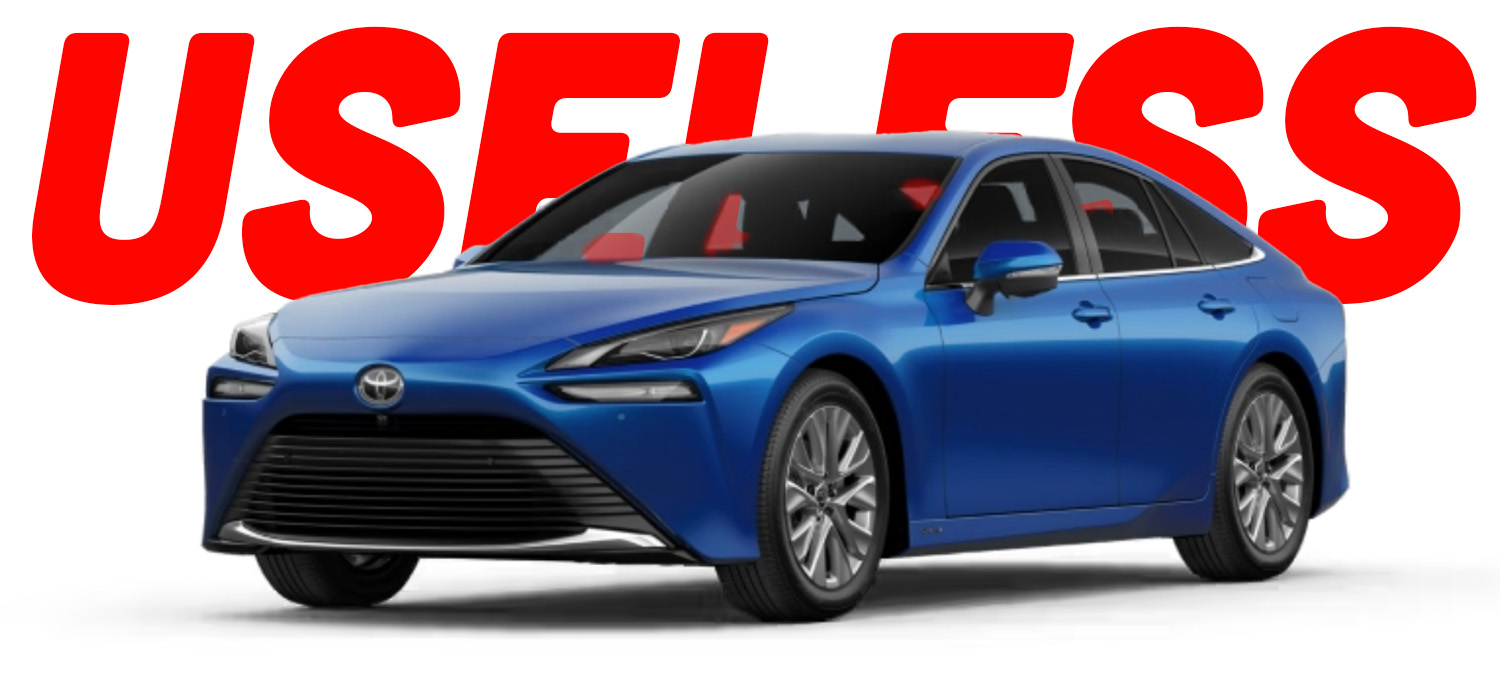
It seems that this severe limitation was not even brought up:
76. Moreover, soon after he bought the vehicle, he learned that hydrogen fuel stations are exclusively located in California.
77. This stifling fueling limitation was not disclosed to Mr. Graham by [REDACTED], [REDACTED], or any other personnel at the dealership during the sales transaction or otherwise. Further, nothing in Mr. Graham’s paperwork he signed with Toyota discloses this critical fueling limitation.
78. Mr. Graham is under military orders to leave California and has left to Virgina, where he cannot bring his car with because there’s absolutely zero fuel out of California.
So, Graham has orders to move to Virginia, but he finds out he can’t take his car there because he can’t refuel it, and when he tries to sell the car back, he finds the appraised value is $11,000, putting him over $24,000 in the hole.
This is, of course, miserable.
Now, sure, one could argue that some of the burden is on the buyer – you should do some research on your car purchases, especially for something as crucial as where it can be refueled. But that only goes so far; the dealer knew this limitation of the car, Graham clearly stated he need to move, and the dealer made no attempt to explain to this potential Mirai buyer that should he move to any place other than Southern California or the Bay Area, that Mirai would be, at best, yard art.
Graham’s example is far from the only one, and some seem to be even more explicit; it also seems that comparisons to the Toyota Prius were used to make the Mirai seem more viable and practical, as in this example involving 77-year-old Jamie Nahman:
102. Critically, [REDACTED] explicitly and repeatedly juxtaposed the Mirai to thePrius.
103. [REDACTED]told Mr. Nahman that the Mirai was going to take off like the Prius and said it was a great deal like the Prius and that Mr. Nahman was lucky that he was getting in early!
104. [REDACTED] made an explicit promise to Mr. Nahman and his wife that within one year hydrogen stations will be everywhere, even outside California.
The Mirai is really nothing like the Prius, aside from them both being Toyotas and being primarily eco-focused vehicles. A Prius can refuel with regular gasoline, anywhere in the world, easily. A Mirai, as we’ve noted, can very much not.
Also, the “explicit promise” that there would be many more hydrogen stations not just in California, but other places, seems downright deceptive.
Of course, there’s a lot more in the lawsuit (and this one isn’t the only one) including many claims of hydrogen fueling station pumps not working, including situations where the pump can literally freeze in the car, limited supplies where owners are restricted to getting 1/5 of a tank of hydrogen, absurdly long refueling times (going against Toyota’s claims of “five minutes“) and complaints that the range of the Mirai is nowhere near the Toyota’s claim of over 400 miles.
In fact, our own David Tracy heard a Mirai owner tell him just that when he spoke to one at a hydrogen fuel station:
Oh, and the fuel is expensive as hell, too, just in case all of this wasn’t enough for you.
I wish I were more surprised by any of this. I’ve driven a Mirai before, and they’re nice enough cars, but they’re also the only car for sale right now that I would absolutely and confidently warn anyone not to buy. Ever. There is absolutely no good reason to buy a Mirai, unless your plan is to have an excuse never to drive anywhere at all, ever – for that purpose, I really can’t think of a better car.
I don’t know if this will finally cool Toyota’s ardor for hydrogen – if it doesn’t, I have no idea what will. But, then again, I never really understood what Toyota’s plan was for hydrogen in the first place. Things definitely don’t seem to be progressing in the way they want, and at some point I would hope dealers will finally understand and be honest what they’re trying to sell to people: one of the most advanced, and well-designed and completely useless (and valueless) cars one can buy on the market today.





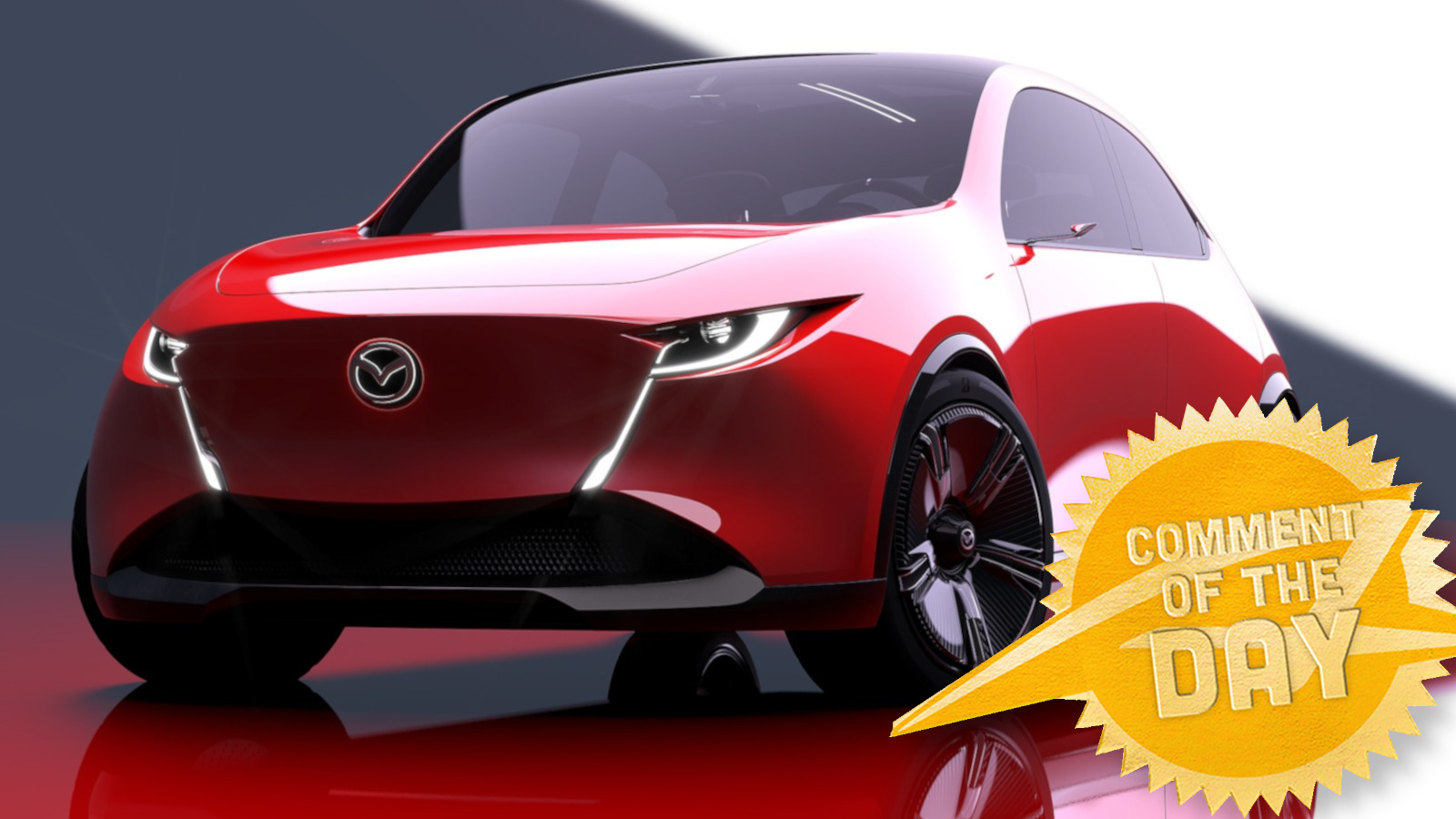

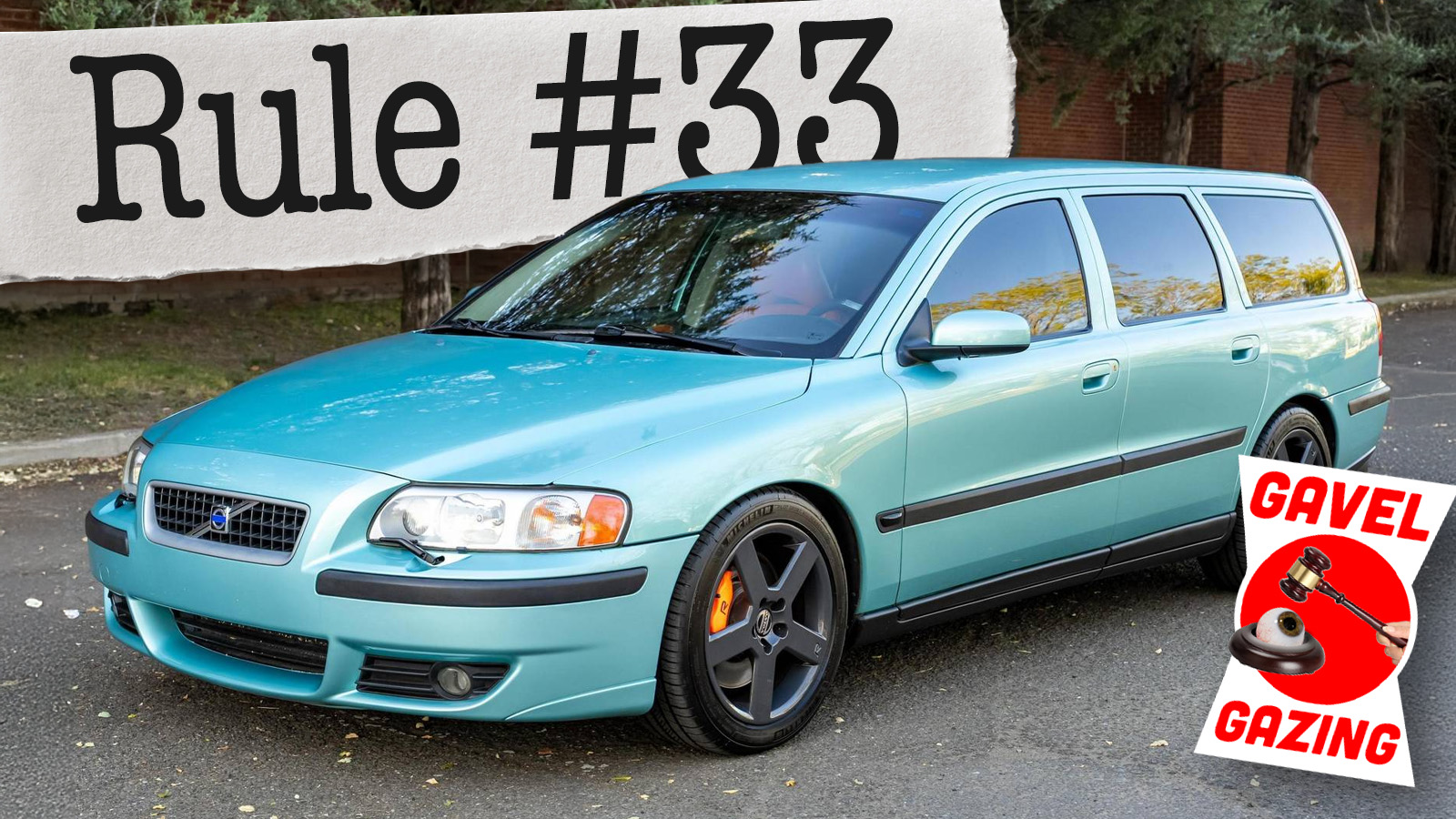
Everyone always wants to go “Well they should know better than to trust a salesman” But my counterpoint is that if a person is lying to you about this kind of thing, they’re actually the one that’s in the wrong, and the law should, and technically does, reflect that
As a former Toyota sales person for a brief time back in the early 90s – the empty promises and outright lies from Toyota sales personnel does not surprise me in the least.
All you need to know about hydrogen’s viability as a fuel is that Mazda, who would do anything to make the rotary engine better, experimented with it in an RX-8 prototype and gave up on it. If Mazda, who stuck with the rotary long after it made sense, did not see a future for hydrogen, then it must have some pretty insurmountable engineering obstacles.
I’m very excited to see what drivetrain swaps people will do with the Mirai. It’s not a bad looking car by any means, and they’re getting quite cheap. A Tesla powertrain is the obvious but boring choice, though a UZ would be really interesting.
The best swap would likely be turning it into a full BEV.
Ditch the fuel cell and hydrogen tanks, use the existing electric motor, add more batteries (it already has a small battery pack) and add a charge port/charger.
I thought of this too (converting a 2nd gen Mirai into a regular BEV since it’s already got drive motors for the wheels, but I imagine installing a bigger battery pack (which will probably need it’s own/a new controller and a charger too) where the hydrogen tank and fuel cell were has got to be a BIG project that hasn’t already been done by others a bunch of times yet (or so I imagine).
While fantasizing, maybe you could use the left over fuel cell and hydrogen storage tank on YOUR HOUSE as a generator during blackouts, though you’d have to figure out how to make the old Mirai fuel cell run on natural gas (already piped to most homes) which is possible (nat gas to fuel cells is already used in various corporate environments including at some Google locations).
But either of the above scenarios would likely be impractically difficult, unless you already had the expertise, time, and money to undertake them.
Also factor in the time/money needed and compare that to the cost of many decent used BEVs you can buy now. Plus the end result of a converted Mirai likely cost more and won’t be better than a used Kia EV6 or Ioniq 5.
BEV conversions only made some sense maybe 20+ years ago where the BEV choices were practically non-existent.
Of course that’s right Mr. Manwich Sandwich (Jeez, I haven’t had a Manwhich in decades! Now I really want one. 🙂 ). The Ionic 5 would probably be my first choice for a used EV (I like the similar EV6, but would rather have the more relaxed suspension and squared-off tush of the Ionic for cargo space).
I already know I’m foolish, but I also like the Mazda MX-30 despite it’s short range (about 100 miles in real life, still way more than I need 98% of the year) and limited sales (they only sold about 600 of them, mostly here in CA). It’s like a CX-30, but a bit weirder. Which is appealing to me (because I’m weird too). But the last time I looked less than a year ago, they’re still about $15K used, which is about $5K more than I want to spend on such a car. Besides, I just bought a 36-year-old Volvo 240 last week to use as my main/daily driver until MX-30 prices drop down to where I would want to buy one, which will probably be at least a few years. 🙂
“ (Jeez, I haven’t had a Manwhich in decades! Now I really want one. ???? )”
Up until recently, there was a bar called Sloppy Joe’s near me. I went there and got a sloppy joe (which essentially is a Manwich).
It was disappointing
And the place has since closed down.
Well, of course, some things are sometimes best in memory, instead of re-experienced in the present. Food, movies, old girlfriends, etc… But I’m a glutton for disappointment, so maybe I’ll get a can of Manwich sauce and buy a pound of ground beef and some soft burger buns and go for it anyway. 🙂
PS: It’s been at least 20 years since I last ate in a bar. My dad was still alive and I took him for lunch at bar in Los Feliz. The burgers were pretty good IIRC, and I was driving, so my dad could have a beer. Time passes so quickly.
I still eat at local bars semi-regularly as there are some near me where the food is actually pretty good. Most recently was during the Toronto Maple Leafs recent playoff run.
And I think a Manwich/Sloppy Joe can be good… it’s essentially a burger with a different meat patty format.
I just don’t know of any place that is doing a good job of it.
I think all that’s needed is to have a great bun, a good sauce mixed with the meat and have some toppings like lettuce, tomato, Jalepeno peppers and maybe some good cheese.
You’re making me hungry!
Toyota’s obsession with hydrogen is pretty easy to explain: it’s a geopolitical and cultural issue for Japanese people. Toyota knows that the ICE/fossil fuel teat will run dry soon or be unprofitable to produce at scale as the rest of the world decarbonizes to varying degrees. But, the don’t want to go EV. Why would any Japanese company who believes to hold a significant amount of the Japanese economy an manufacturing capacity want to make themselves and their country dependent on a country that they have aggressed for a century and a half very recently (relatively speaking).
I remember reading once Toyota developed their hydrogen fuel cell technology when Japan was developing multiple nuclear power plants and hydrogen, as a byproduct, was going to be plentiful. Then Fukushima happened and Japan soured on that.
I’m personally all for nuclear power and want more of it.
Sure, screw these salespeople in particular but… do your research on your massively expensive purchase.
Honestly with a company like Toyota with the resources available, and Push for this type of vehicle versus full electric from them, it is a little disheartening that they did not at least Benchmark tesla with their charging network. Yeah it might be a bit of an upfront cost thing but it is a gamble that could pay off on not just your own vehicle sales, but others if the cars are as good as you think. The fact that they did not do it, kind of makes it seem like these cars are not as good as one might expect.
Japan currently has less than 200 hydrogen charging networks in place. There are plans to make that 1000, but not for another half decade or more. That’s where they should have invested in the network. Japan, with its much smaller geographic footprint, would have been excellent proof of concept that showed the rest of the world that it was viable and feasible. If they showed it working there, private investment here would be clamoring for it in the US. Wawa has the tesla network, thorton’s could have the hydrogen.
I still contend that Hydrogen is *not* a fuel, it is a storage medium. Just like batteries use an outside source of energy to store a chemical reaction, hydrogen uses outside energy to separate H2 from water by electrolysis or from natural gas by stripping the carbon and leaving the hydrogen. In both cases, you never get back all the energy that you put into the initial chemical reaction. Hydrogen just has the inconvenience of requiring more energy be expended to cool and compress it into expensive holding vessels. All in all, a dead end technology.
The Mirai is Toyota doing a real world experiment with fuel cell durability with customers paying the bill. I suspect they are mostly interested in fuel cell due to their ownership of the medium and heavy duty truck brand Hino – I segment that is not easy to convert to battery electric.
We will see if my suspicions are correct soon – as Toyota is spinning off Hino. Toyota’s Hino is merging with Daimler Trucks’ Fuso brand to make a new independent company. Each will retain 25% ownership and the rest will be sold to raise some $$$$. CEO of the new company will come from Daimler.
As I understand it, the fuel cell is still electric in the end, it just uses a fuel cell in place of a battery and essentially makes it’s own electricity. in theory far more efficient than making it on a grid, inefficiently converting it and transferring the power and then storing it and transferring again.
The whole Pesky containment of Hydrogen and Nagasaki level explosion concerns of course make the average joe nervous still, but I am not sure it is any worse than a runaway EV battery in the end.
You have that backwards. Battery electrics are far more efficient than hydrogen fuel cells. It takes roughly 3x more electricity per mile to use electricity, to make hydrogen, which is then compress and sometimes cooled to a liquid state, then converted back to electricity to power the vehicle.
The economics don’t really work for vehicles UNLESS – it is for an application where the fuel portability and energy density of hydrogen is actually required. Applications like aircraft, heavy duty trucks, construction equipment working away from the grid, etc.
The above assumes a goal of renewable energy production with no downstream local emission from the vehicles. If those aren’t goals / requirements then hydrogen makes absolutely no sense as both natural gas and diesel vehicles are far cheaper to make and fuel.
you are thinking about the Hydrogen production side. Particularly you seem to be focused on electrolysis of water.
Most Hydrogen uses the steam Methane Reforming process currently, and if the steam comes form electric heat then I would say you might be correct. Most of the time it is caused by burning a fossil fuel though, so i get it, just like a lot of electricity generation these days, it mostly just moves the emissions from one place to another.
Fuel cell design involves creating a system that efficiently converts chemical energy into electrical energy using electrochemical reactions, typically with hydrogen as fuel.
There is no reason to make a hydrogen fuel cell vehicle if you are just going to strip H2 from methane. It is far more efficient just to use that methane in a CNG / CLG vehicle directly. The entire point of fuel cell vehicles is to reduce emissions and switch to a renewable fuel.
Here is VW’s breakdown on the efficiency of a FCEV vs a BEV
https://stockhead.com.au/wp-content/uploads/2021/08/ev_vs_hydrogen.jpg
Many years ago, I got to spend a few weeks with GM’s Project Driveway hydrogen car– back at a point when a future of electrified vehicles and/or future hydrogen ones both seemed plausible, (our household swung both ways: we also got one of the first available Prius’s, back in the initial window when you had to buy them directly from Toyota because they didn’t want dealers marking them up).
The Project Driveway vehicle was, like the Mirai, unremarkable but perfectly fine to drive. Refueling it was NOT perfectly fine. It was slow and wonky, in part because everything about the process was basically in beta-testing, but in part because loading up the fuel tanks to store hydrogen under high pressure required lots of safeguards– and had lots of safety tripwires that almost always slowed or halted the process. Even with all the snafus we’ve seen in building out a fast, smooth-running charging network for electric vehicles, I imagine that a build-out of a hydrogen network would have been a whole lot worse.
I tell you what, if Mr./Ms. Redacted ever tries to sell me something I’m NOT buying it. This person did a whole lot of fibbing!
Yeah! Also, I prefer propane and propane accessories, I tell you what…
I’m not saying that people are trying to have it both ways, but I suspect a number of people on that list knew they were signing up for the chance hydrogen would expand and the free fuel deal that was offered (which, admittedly, was a deal that no one was going to take full advantage of, given the limited area one could reasonably drive a Mirai). The thing about these class actions is that they’ll try to find everyone who could be a member of the class, then they’ll highlight these stories where someone was truly deceived.
But screw any dealer that was trying to convince people the Mirai was some great option for most people. I hope the dealers pulling that crap get hit with most of the liability and Toyota drops them. It’s one thing for Toyota to send over some cars and try to make
fetchhydrogen happen, it’s another to pretend it’s a sure thing.I have a feeling that the lawsuit won’t get very far. Toyota is not responsible for the shady shenanigans of their stealership network as they are businesses who are independent from the manufacturer.
If the lawsuits were against the dealers, then maybe they’d have a case.
It sucks for all involved here, but even when Toyota were selling these new, you’d have to know what a gamble it would be to buy a hydrogen-fueled vehicle. I mean it’s not like we have zeppelins flying all over the place these days that need a place to top up their big balloons.
I rode in a 1st gen Mirai in Japan. The owner was an older Japanese businessman we knew who was trying to set an example for others about ecological responsibility, and he really liked it. I enjoyed riding in it because I knew that it would probably be the only Hydrogen powered car I’d see and the styling was unusual both inside and out, but ultimately the riding experience was very ordinary. He liked it but I think he mostly drove it near his residence in Nagoya.
If they sold a car that ran on unicorn farts, wouldn’t you want to be damn sure this new, mythical, unicorn fuel was available to you?
What possible reason would one buy an incredibly limited hydrogen fuel vehicle rather than a Prius, a Rav4 or Camry? If you can “do the math” on saving with “free hydrogen”, can you not also do the homework to notice that there absolutely is no hydrogen ecosystem other than a tiny CA testing ground?
Toyota bares some fault here but the people who bought these should feel shame for making such a terrible buying decision.
Buyer beware. I have close to zero sympathy for people who bought these. Two minutes on the interwebs and it is clear what the limitations are. That said, refueling them seems like a nightmare but it all still falls in the “there just isn’t any real hydrogen infrastructure” umbrella. And reading about the guy who realized after he bought it that there were only stations in California? C’monnnnn….
The internet’s given us a wealth of information at our fingertips, but somehow, I think all it’s done is made us dumber.
The idea of relying on a salesman for accurate information about basically anything is absurd on its face (to me)
Yeah, but that TruCoat!
I have a friend who is very successful in his life- Self employed, married with two great kids (who happen to be friends with my kids), marathon runner and one of the kindest and most generous people I know. He is also very open about the fact that he is always very careful when shopping for big items because “I can be sold anything very easily.” He brings a family member with him for every major purchase to help make sure he isn’t sold a bill of goods. He’s the guy that, without that person with him, would be sold tru coat, scotch guard, pinstripes, nitrogen fill, etc.
The people on this lawsuit might just not be self aware enough to know that they easily fall for a sales pitch. There’s personal responsibility to be sure, but I do have empathy for their situation.
“I never really understood what Toyota’s plan was for hydrogen in the first place.”
The plan was for Toyota to get R&D money from the Japanese government, and then they do the minimum amount of automotive development. The Toyota Group is a conglomerate, so they do not have to make their money selling cars with the technology they come up with.
There is a product in Japan called the Ene-Farm that sold 500k units last year. It is basically a fuel cell water heater that generates 700w of electricity as it makes hot water. It can run on natural gas or hydrogen. Toyota and their fuel cell supplier Aisin are two of the companies involved.
The plan for the future is to charge up your Prius Prime overnight from your underfloor heating system that uses natural gas running through a fuel cell designed by Toyota.
“hydrogen is the most abundant element in the universe, after all”
Hmm, you know what’s even more abundant throughout the universe than hydrogen?
Electrons!
So logically we should be powering cars with electrons, right?
RIGHT??
“and also claims that Toyota dealers dramatically oversold the usability of Mirais and did not adequately warn potential buyers of the severe limitations of the car.”
Two words: Due diligence.
OK, I’ll add a third
Duh!
Right, like there’s some magical way to harness the power of electrons to propel vehicles. I suppose next you’ll tell me I can light my home with them or send messages to strangers across significant distances via some magical box powered by these subatomic particles.
Or that magical way to harness the power of electrons can be done by installing some panels on your roof!
Totally sounds like crazy-talk to me!!!
Not only that you can shoot them from a GUN!!
The saddest part is they are driving a new Toyota that isn’t hideous and looking like something from a 1950s Japanese bottom of the sea Godzilla ski fi movie. Let’s be honest, most new Toyotas are not pretty to behold.
The other day I was following an interesting-looking car on the freeway. When it accelerated, a little puff of liquid shot out of the tailpipe. Imagine my delight when I pulled closer and saw the Mirai badging! That little puff of liquid was pure water!
From a technical standpoint I think it’s a brilliant car, basically as a proof of concept for hydrogen fuel cells. But as an actual, practical vehicle that has vehicular needs? Only if Toyota was paying me to drive it.
Slowly becoming more Libertarian with such a “how was I supposed to know” lawsuit and a dealership. A CA dealership and it’s employees are not going to care about VA and likely imagine that CA is VA of they’ve never been there, which enforcing the fact that they shouldn’t care in the first place. Also, auto dealers and there ability to pull as much money from service members is as old as time. Nothing like a ‘big’ check and new fast cars bringing the chicks home amirite?
I lost count of the new young privates who bought shiny new fast cars, only to see them sit unused while on field exercises, or just become familiar with every MP on post with a radar gun. One company commander just rounded up every private with a speeding ticket for extra duty on a regular basis. Never ran out of “volunteers”…
And then they’d get transferred to a new post and that car would sit at the PX with a For Sale sign for months because they couldn’t take it along for whatever reason.
I’ve seen a lot of publicity over how much we should appreciate/respect vets and servicemembers (which I do appreciate), but if you take a close look at the businesses within a mile or so of the front gate of any base – especially training bases – you’ll get a whole different perspective on why soldiers are appreciated by the local community.
IIRC, we lost a few bars and one tattoo parlor from the end of town where the Naval Air Station was when it shut down back in the mid 1990s. Still several bars and one tattoo parlor though! After all, it’s not only sailors who like to drink and get inked, not necessarily in that order.
There is zero chance the dealer didn’t know exactly what they were doing and made a sucker out of what I assume to be a fine military serviceperson. Fuck them.
I don’t hate Toyota, but this was a boondoggle purely of their own making. They need to buy all these cars back for purchase price minus some fair deduction for miles used.
I want to see someone buy a Mirai, take out it’s hydrogen system and replace it with a battery or put an ICE range extender, but it definitely needs to be able to plug in.
I’d like to see them put in the system Nissan was testing in Brazil, runs on Ethanol, uses a reformer to turn the ethanol to hydrogen to power the fuel cell. Theirs ran on E100, but maybe could be adjusted to run on E85. There may be a couple more E85 pumps available than hydrogen.
And how is that better than just burning the ethanol?
More efficient and mechanically simpler.
Maybe, maybe not.
Since this is a Nissan I will point out they has a. REX ICE engine with a claimed 50% thermal efficiency:
https://www.nissan-global.com/EN/INNOVATION/TECHNOLOGY/ARCHIVE/E_POWER50/
Now lets compare the performance of the e-NV200 ( 174 miles on 40 kWh) vs this EFC NV200 (374 miles on 30L or 7.9 gallons).
https://www.whatcar.com/nissan/e-nv200/van/review/n20139
https://www.cnet.com/roadshow/pictures/nissans-finally-put-its-ethanol-fuel-cell-into-a-vehicle/
Because these are both electrified NV200s I think its OK to assume outside factors such as aerodynamics, weight, rolling resistance, electronics, etc cancel out.
Ethanol contains 22 kWh/gal so 7.9 gallons of ethanol yields 174 kWh of power. Assuming that range of 374 miles is powered solely from that 7.9 gallons of high test booze and not from the 24 kWh battery we get 2.15 mi/kWh
The e-NV200 gets 4.35 mi/kWh. So compared to the BEV the EFC is 49% efficient, maybe less since its unclear if the 24kWh battery was used in a PHEV mode.
Of course this is a crude guesstimate and real world efficiency is probably somewhat lower so I think it’ll be at best a toss up between the two. Then the questions then becomes which between the REX ICE and EFC is cheaper to manufacture, more reliable, easier to package, etc.
Oh sweet. Brazil has plenty of E100 pumps for those of course. E85 might be a heavy lift depending on whether the fuel formulations would poison the reformer/catalyst.
Methane, methanol or ethanol are great fuels for FCVs, easy to get and handle. But nooo, they had to use the “perfect” fuel…
That is exactly what I was going to say! You get a terrific, almost brand new car for the cost of a clapped-out Corolla. Ditch the hydrogen parts, add more batteries, a controller and a charge plug, and Bob’s your uncle! It would take some technical know-how, and some investment in the batteries, but you’d end up with basically a brand new car for a third or a quarter of the price of anything similar.
The systems are the nightmare. I shudder to think of all the constant warning light and errors. Only Toyota knows just how tightly integrated the modules and code really are and they aren’t going to help.
I wonder how much one could get for a gently used HFC on Ebay.
There is one for a 2016-18 listed now for $13,999 plus 300 for shipping, reduced from $17,499.
Ironically, you can get a complete 2021 Mirai for $11,488 or $12,999.
(There are also a couple older ones at 6,250 and 6,000.)
PROFIT!!
I will do this if they sell me one for $11.00. Promise.
What’s the usual refrain here? “LS swap” or something like that?
LS swap everything!
They even already have a small traction battery, I think packaging and interfacing would be the main difficulties.
And then get a methane -> H2 reformer and use the fuel cell to power your house on natural gas!
Not just your house, but your converted Mirai too!
I have continued to be baffled how Toyota could never seem to understand that they were going to have to contribute to building the infrastructure if they actually wanted hydrogen to happen.
They are still in the research phase and personal cars are not the real target market for fuel cells.
Guess that’s why Honda is about to launch a plug-in hybrid fuel cell CR-V… can just keep charging it when you can never find hydrogen.
But seriously OEMs, give up on this hydrogen passenger car dream.
Can’t wait for all the articles about how Honda “built a 25 mile range EV.”